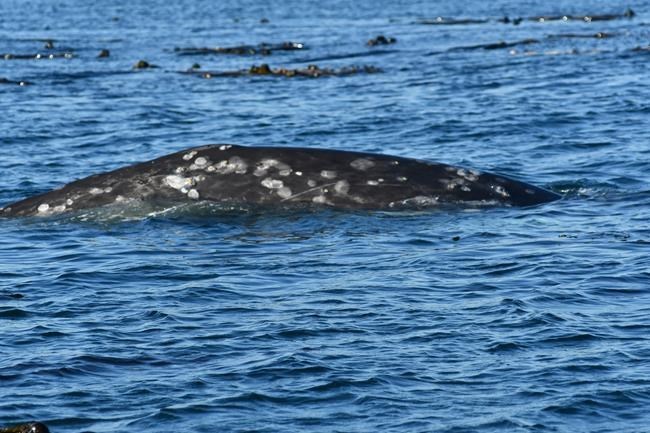VANCOUVER — Canadian and American officials say they're monitoring a grey whale after lesions were spotted in the same area where a satellite tag was attached by researchers.
Officials said during a joint news conference Tuesday they've taken the whale's breath sample and given it antibiotics, and it appears to be active and doing well in the waters off Vancouver Island.
Photos show the tag protruding from a patch of the whale's flesh, which appears white around the foreign object.
"The whale is fairly robust, it's feeding," said Marjorie Mooney-Seus, a spokeswoman for the National Oceanic and Atmospheric Administration in the United States, which administered the tag.
"It is behaving normally and making quite long trips up and down the coast of Vancouver Island."
The animal is part of a small group of about 250 grey whales that spend their summers in the waters off British Columbia and Washington state.
The Committee on the Status of Endangered Wildlife in Canada designated the Pacific Coast Feeding Group endangered in 2017 and the pod is under consideration for protection under the Species at Risk Act. It is not considered endangered in the United States.
Stephen Raverty, a veterinary pathologist with the B.C. government's Animal Health Centre, said the whale is being monitored for the same type of fungal infection linked to a tagging that killed an endangered orca in 2016.
NOAA temporarily suspended its tagging program after the death of the whale known as L95.
"Fungi is certainly a consideration in this case as well, however there's no real way to determine whether there is a fungal infection involved in this site," Raverty said.
The breath samples are being studied for fungal culture, as well as viral and bacterial content, but results will take two to three weeks, he said.
Martin Haulena, a veterinarian with the Vancouver Aquarium and Marine Mammal Rescue Centre, said there's likely bacterial inflammation around the tag but the antibiotics are mainly designed to prevent a more serious spread.
"Their purpose is to prevent an overwhelming secondary and systemic infection," Haulena said.
The whale was tagged Sept. 8 by researchers with NOAA Fisheries, said Sharon Melin, program manager of its California Current Ecosystems Program.
The tags are designed so that the whale's body will reject them over time and heal over, a process that can take from one month to over a year.
Safety protocols, including sterilization of the tag before deployment, were followed, another official said.
The lesions were spotted both around the tag and on the opposite side of the animal on March 16 by a NOAA contractor.
A panel of scientists determined on March 31 that the lesions do not pose an imminent danger to the animal's health, Melin said.
"The consensus of the panel was that the lesion around the tag site was within the range of reaction that would be expected as the body extruded the tag, however it was unusual compared to other records of whales tagged with similar tags," Melin said.
The panel does not know if the lesions on the other side of its body are related to the ones around the tag, she said.
NOAA said in a statement that it is hopeful that once the tag falls off, the tissue around the site will heal.
Satellite tags are an important part of the way scientists learn about the whales' migration, habitat, feeding and breeding areas, as well as identifying where they share the waters with humans, Melin said.
There are about 20,000 whales in the entire Eastern North Pacific grey whale population, including this whale's small group. The larger group has fully recovered from the historic whaling era and was taken off the endangered species list in the United States in 1994.
This report by The Canadian Press was first published April 13, 2021.
Amy Smart, The Canadian Press



